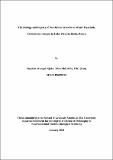| dc.description.abstract | Lake Victoria, like other large lakes in the world, is a shared resource and forms an international boundary between Kenya, Uganda and Tanzania. It is the second largest fresh water lake in the world with an area of 69,0000 Km2, a convoluted shoreline of 4800Km and a volume of 2,700km3. The lake lies in one of the most populous regions in the world, serving as a source of livelihood for some 30 million people in Kenya, Uganda and Tanzania who depend on it for fisheries, transport, power generation, biodiversity conservation, tourism, recreation, agricultural, industrial and domestic needs. Current estimates put the annual fish catch between 400,000 and 500,000 metric tonnes generating some US$300-400 million. In Kenya about 90% of the total fish landed is from this lake. Its fishery directly employs about 100,000 people but more than 2 million people are involved in other indirect activities. The invasion of this strategic water body by the worlds worst aquatic weed, water hyacinth, Eichhornia crassipes in the early 1990s posed a serious challenge to the widely acknowledged biological control strategy. In its native range in the Amazonian Brazil, its natural enemies keep the weed in check. The most important of these are two Curculionidae weevils, Neochetina eichhorniae and N. bruchi. While control has been attained with remarkable success elsewhere in the world using these agents, no information is available on the biology, population dynamics and their impact on water hyacinth in the Lake Victoria Basin. These studies were therefore aimed at quantifying and filling these information gaps. The mean fecundity of the two weevils was recorded as 290 and 237 eggs per female laid over a period of 16 weeks, with an adult longevity of 98 and 112 days for Neochetina bruchi and N.eichhorniae respectively. A two-way analysis of variance showed there was significant difference between the egg laying capacities of the two weevil species (p=0.002). The survival rate of the two species was significantly different (p<0.05) for all life stages except for larvae to pupa. There was no significant interaction between the species and the method of egg setting (p<0.05). These studies were conducted in an open laboratory at KARI, Kibos. The impact of these weevils on water hyacinth was evaluated at 3 satellite ponds each in the riparian districts of Busia, Kisumu and Nyando. The parameters evaluated were fresh weight, number of ramettes, petioles, feeding scars, percent damaged petioles, laminar area and petiole length. The comparative field survival of the weevils was evaluated by recording the number of adults, eggs, larvae and pupae recovered at every site. A sample size of 18 plants was used at every site, with sampling conducted once every month for 12 calendar months at Okana (Kisumu) and Otho (Nyando). Data for Budalangi (Busia) was taken for six months only. The percent damaged petioles were consistently higher with an increase in the number of larvae (the most destructive stage) at all the sites. These weevils are effective biological control agents and for maximum results, they should be used synergistically for the control of water hyacinth in the Lake Victoria Basin. | en_US |

